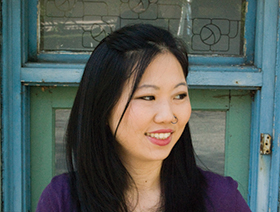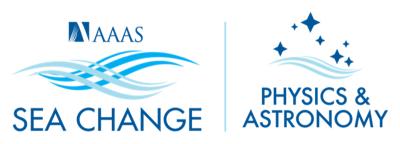We’re Past Due for a SEA Change
Fall
2020
Feature
We’re Past Due for a SEA Change
Photo courtesy of Alexis Knaub.
 While it’s no secret that we in physics and astronomy still have much progress to make, our field has begun the journey of addressing the disproportionate challenges faced by our colleagues from groups underrepresented in physics, including those who are Black,1 Latin American,2 Indigenous,3 Asian,4 female,5 LGBT+,6 and/or are disabled.7
While it’s no secret that we in physics and astronomy still have much progress to make, our field has begun the journey of addressing the disproportionate challenges faced by our colleagues from groups underrepresented in physics, including those who are Black,1 Latin American,2 Indigenous,3 Asian,4 female,5 LGBT+,6 and/or are disabled.7
A major issue we must confront is that many of our learning and work environments aren’t set up for all of us to thrive as our whole, authentic selves. There are many reasons for this, ranging from systemic barriers to individual actions. There are people in physics who blatantly promote harmful beliefs or actions. There are also many people who mean well but subconsciously cause harm.
All of us have unconscious biases, beliefs, or preferences of which we are unaware and for which we lack supporting evidence.8 For example, the editor-in-chief of Physics World noted a time he assumed two astronomers in a story were middle-aged white men when, in fact, they were young women.9 As the author points out, his unconscious bias—assuming an astronomer is a middle-aged white man—can have other impacts, such as whom he selects for different jobs. Because they are not deliberate, unconscious biases are hard to unseat. Becoming aware of them and actively working on them are important first steps.
To provide the best possible environment for everyone in our departments, those who witness or learn of problematic situations have a responsibility to ensure harm doesn’t continue. We must dismantle barriers rooted in racism, sexism, homophobia, biphobia, transphobia, ableism, and more. These barriers have nothing to do with learning or working in physics and are detrimental to the progress of the field. To do so, departments must work together internally and with support from the broader community.
Encouragingly, the scientific community has been making efforts to understand and improve the experience of marginalized students, faculty, and staff. The AIP TEAM-UP project is a prominent example of such an effort, focusing specifically on African American students in physics, and is described in greater detail elsewhere in this issue.1 Additionally, site visits from professional society committees can provide information on how a department is faring, where they can find additional resources, and what they can do to improve. Most recently, members of the physics and astronomy community have begun a pilot project that involves a self-assessment and action plan process to help spur change at the department level.
SEA Change

The American Association for the Advancement of Science (AAAS), inspired by the United Kingdom Athena SWAN project, aimed at improving gender equity, launched an initiative to address bias, marginalization, and exclusion on the basis of gender, race, ethnicity, ability, socioeconomic status, sexual orientation, age, and the intersections between these identities in science, technology, engineering, mathematics, and medicine (STEMM).10,11 This initiative is the STEMM Equity Achievement (SEA) Change project.
The Physics and Astronomy SEA Change project is a pilot project to support physics and astronomy departments in changing their cultures to support those who are marginalized and cultivate an equitable and inclusive community for everyone.
The AAAS SEA Change initiative began at the institutional level. Universities and colleges embarking on the SEA Change process first undergo a self-assessment to better understand how effectively their institution is serving underrepresented students, faculty, and staff. The self-assessment, which entails data gathering and
reflection, can reveal what might not be apparent to university and college leaders. This process aims to establish a baseline set of facts for comparison. This looks different for each institution. From there, institutional leaders develop a five-year plan to address aspects of their institution that aren’t equitable. Their plans must be rooted in the data from the self-assessment and provide ways to track how their plans are addressing the issue(s) identified.
These plans and the rationale behind them are reviewed by a committee which awards distinction to institutions with solid plans for progress. After five years, institutions are encouraged to revisit their self-assessment and reapply to renew their award. So far, three institutions have received awards. Their plans include steps such as implementing bystander intervention trainings and creating policies that ensure members of underrepresented groups are not asked to serve on too many committees, which is a common issue.12
The Physics and Astronomy SEA Change pilot project is analogous to the AAAS SEA Change institutional-level project in that it includes a self-assessment and award structure but functions at the departmental level. Participating departments will build a baseline for their processes and evaluate historical trends and statistics. Through this process they can evaluate their standing on a wide variety of issues that impact those that they wish to educate and serve. This pilot project is guided by representatives from physics and astronomy professional societies, including the American Association of Physics Teachers (AAPT), American Astronomical Society (AAS), American Institute of Physics (AIP), American Physical Society (APS), the National Society of Black Physicists (NSBP), the National Society of Hispanic Physicists (NSHP), the Optical Society of America (OSA), and SPS and ΣΠΣ.
Why create a departmental self-assessment and award system if an institutional program already exists? Departments in postsecondary educational institutions have considerable autonomy, ranging from what is taught (and how) to graduate admissions to faculty hires. Thus, although not completely removed from institutional constraints, departments have a lot of agency over day-to-day realities and, ultimately, the culture and climate of the department.
This academic year, the Physics and Astronomy pilot program hopes to support a few departments as they work through the self-assessment. In this way, we can test drive the program and determine its feasibility for physics and astronomy departments. If successful, we plan to scale up and support more departments in their work to remove barriers and create conditions for everyone to thrive.
Let’s get to work
The act of creating a truly equitable environment for all students and faculty can feel overwhelming. There is a vast gray area between active discrimination and inclusivity. Where a department lies on this spectrum can profoundly impact people, especially those from historically underrepresented groups. The SEA Change approach focuses on self-assessment and data, but the goal isn’t just having a representative number of individuals with various identities in a program. People spend considerable time working, learning, and socializing in their departments. Creating environments where all individuals can thrive is the goal. Reaching that goal entails confronting harsh realities and making meaningful efforts to change the culture.
This is not a trivial undertaking, and we must rise to the occasion.
Through actions we take as individuals and collectively in departments, we can implement the changes necessary to establish a diverse, inclusive, and equitable field. Together, we can make sure everyone is welcome in the physics and astronomy community.
References:
1. “The Time is Now: Systemic Changes to Increase African Americans with Bachelor’s Degrees in Physics and Astronomy,” American Institute of Physics, College Park, MD, https://www.aip.org/sites/default/files/aipcorp/files/teamup-full-report....
2. “Physics Programs at HSIs,” http://www.hispanicphysicists.org/eupphsi/talks/Burciaga2.pdf.
3. “Perspectives on the Indigenous Worldviews in Informal. . . .” Oct. 16, 2017, https://aapt.scitation.org/doi/full/10.1119/1.5008336.
4. “Dressing up racism as a compliment just doesn’t . . . - Phys.org.” Jan. 6, 2020, https://phys.org/news/2020-01-racism-compliment-doesnt.html.
5. “Common Challenges Faced by Women of Color in Physics. . . .” Aug. 23, 2017, https://aapt.scitation.org/doi/10.1119/1.4999731.
6. “APS LGBT Climate in Physics Report - American Physical. . . .” Oct. 13, 2015, https://www.aps.org/programs/lgbt/upload/LGBTClimateinPhysicsReport.pdf.
7. “Perspectives from students with disabilities - ComPADRE.org.” https://www.compadre.org/per/items/4948.pdf.
8. Psychology Today. 2020. Bias. [online] Available at <https://www.psychologytoday.com/us/basics/bias>
9. “Surely you’re not biased – Physics World.” Mar. 10, 2016, https://physicsworld.com/a/surely-youre-not-biased/.
10. “AAAS SEA Change.” https://seachange.aaas.org/.
11. “SEA Change honors diversity efforts by universities | Science.” May 31, 2019, https://science.sciencemag.org/content/364/6443/844.
12. “Stopping the leaks | The Lasker Foundation.” June 17, 2019, http://www.laskerfoundation.org/new-noteworthy/articles/changing-culture....
